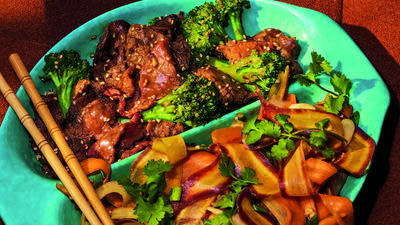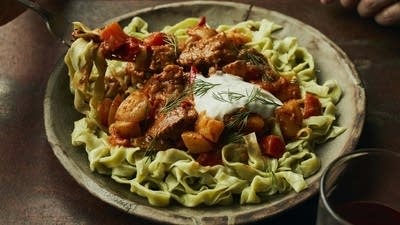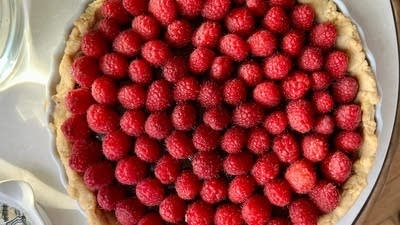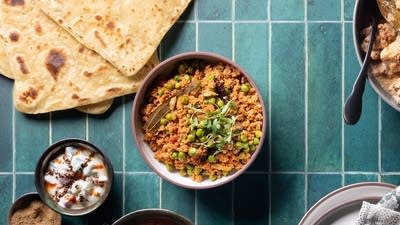
For the?Thanksgiving dinner?I'm sharing with you this week, I wanted a really lush centerpiece, one that celebrated the beauty of the fall harvest but didn't cost me hundreds of dollars. So I turned to my favorite eco-friendly florist to help me create a beautiful, all-natural vegetable centerpiece that a real human (you know,?homo sapiens, as opposed to?marta stewartensis) could make with some seasonal vegetables, basic tools, and a little imagination.
But I didn't want to let all that beauty go to waste, after the meal. Since nothing is glued down or otherwise rendered inedible, you can eat nearly every piece of this arrangement ¡ª and I give you recipes to help you do just that.
 Photo: Rachel Joy Baransi for The Kitchn
Photo: Rachel Joy Baransi for The Kitchn
While I love flowers, I think that vegetables deserve a moment in the spotlight at Thanksgiving, and placing them in the center of the table reminds us that we can turn back to the bounty of the harvest when the indulgence of pie and gravy is over.
So I approached Eva Provenzale, my favorite florist here in Columbus, Ohio. Eva's business,?EcoFlora, specializes in local, organic, and sustainable flowers. I've had many arrangements from Eva that include seedpods and herbs, offbeat roadside flowers or native Ohio grasses. Her arrangements are natural and thoughtful, always with a flair for the unexpected.
Of anyone, I thought that Eva might be able to do something beautiful with a sack of vegetables. Lucky for me, she was up for the challenge, despite the fact that she had given birth to her daughter just a few weeks prior. This hasn't slowed her down; she's running her shop and arranging flowers with her daughter Elliott tucked into a sling.
So I rolled into her shop a few days before the party, lugging bags of vegetables that had caught my eye for one reason or another. I had beets, turnips, cabbage, kohlrabi, eggplant, and papery-skinned tomatillos. I also had a wide, light wooden platter, a good find from a local shop. I had been searching for the right base for the arrangement, finding only very expensive options online. But this one, a platter from Mix:Home, was only $33, and simply perfect.
Eva laid everything out, then got to work. Here's how she put it all together, without the aid of floral foam ¡ª which, she pointed out, isn't biodegradable. She made a point of only using food-friendly materials to assemble this arrangement, and we took step-by-step photos to help you do it too.
 Photo: Rachel Joy Baransi for The Kitchn
Photo: Rachel Joy Baransi for The Kitchn
What You Need
Supplies
Dried vine, such as bittersweet?
Selection of fresh fruit and vegetables in a range of sizes and colors, such as turnips, cabbage, eggplant, tomatillos, beets with their tops, grapes, squash, kohlrabi, and pomegranate
Equipment
Large, slightly curved platter or board, such as?this one
Cardboard
Shears or florist's clippers
Masking tape or floral tape
Food-safe wooden skewers
Instructions
?
[Ed. note: Find a step-by-step tutorial with photos?here.]
Gather your materials.?This arrangement works best when you use a range of colors, sizes, and shapes. I browsed my local market for good-looking vegetables, attracted to the violet blush on the turnips and the ruffled leaves of Savoy cabbage. Make sure some of the vegetables have stalks and leaves, like beets with their greens.
Cut up cardboard.?Eva began by cutting up some scrap cardboard and stacking it into a support for the center of the arrangement. "I don't use floral foam," she explained. "A lot of people don't realize that it's not biodegradable."
Stack the cardboard and tape it together.?Eva taped the cardboard into a sturdy base that will help give some height to the arrangement.
Place the cardboard stack onto your platter.?Eva put this right in the middle, although you could also offset it to make your arrangement cascade from one side to another.
Tape the cardboard stack to the platter.?Tape the base down firmly.
Choose a long coil of bittersweet or grapevine.?Eva explained that she thought the arrangement would need something "stick-y" to form a base for the vegetables.
Coil the vine around the base of the platter. Weave it under the tape holding the base on the platter.
Start with the biggest vegetables.?Place one of the biggest vegetables (in this case, a Savoy cabbage) on the platter, to the side of the cardboard base, and see how it looks. Position it until it seems secure.
Use a skewer to hold the cabbage in place.?Eva used a food-safe bamboo skewer, run through the core of the cabbage and into the cardboard, to hold it in place.
Add anything else leafy. After putting the big showstopper cabbage in place, Eva placed the kohlrabi and beets, both leafy and long, which made a good base for what would come next.
Begin layering in other pieces.?From here, it's really up to your imagination and the vegetables you have. Eva placed tomatillos and grapes on the base of the beets and kohlrabi leaves.
Keep using skewers to hold larger pieces in place.?Eva wanted to add a red cabbage so she skewered its base and clipped off the extra length of skewer, then shoved the skewers into the cardboard base.
Add the smaller vegetables, tucking them into bare corners.?Look for areas in the arrangement that seem empty, and tuck turnips and other smaller vegetables in, using skewers if necessary to hold them in place.
Finish with a few more long sprays of leaves or vines.?For a dramatic finish, tuck in a few sprays of leaves. We used rose branches from the rose bushes outside my house. The rose hips also got tucked into the arrangement.
Notes
Clean up the vegetables:?Don't forget to clean up the vegetables before using them. You can even rub them with a little vegetable oil to help them shine
How to store:?I have an extra fridge in the basement, so I left the arrangement there for a couple nights. But you could also just leave it in any cool spot; it should last well (see the next point).
How long will this last??This was a remarkably hearty arrangement. With the exception of some of the softer vegetables, like the eggplant, this lasted for over two weeks at my house. I began plucking vegetables away to cook them, like the eggplant and cabbage, but I left others sitting on the platter until I needed them (well, until it started looking really picked over!). But you could certainly put it together some days before Thanksgiving.
 Photo: Rachel Joy Baransi for The Kitchn
Photo: Rachel Joy Baransi for The Kitchn
Eat Your Thanksgiving Centerpiece: The Recipes
After assembling all these beautiful vegetables, though, the last thing I wanted to do was throw them away. Since we were careful to use only food-friendly arrangement techniques, everything could be eaten afterwards. And what better menu, the week after Thanksgiving, but the one you find in a pile of gorgeous vegetables?
Here are plenty of recipe ideas for the things I put in my own arrangement. Keep in mind, too, that most of these vegetables will last a long time; cabbage can keep for a month in the refrigerator. So you don't have to race through them.
Beets
How To Roast Beets in the Oven
Roasted Beet Salad with Barley, Feta, and Red Onion
Cabbage Beet Coleslaw
Five Ways to Eat: Beets
Red, Green, or Savoy Cabbage
Grilled Cabbage Wedges with Spicy Lime Dressing
Roasted Cabbage Slaw with Hazelnuts & Lemon
Roasted Cabbage with Bacon
Hot & Sour Mushroom, Cabbage, and Rice Soup
Cabbage in Mild Yogurt and Mustard Seed Curry
Eggplant
How to Cook Eggplant in the Oven
Roasted Eggplant Salad with Smoked Almonds & Goat Cheese
Baba Ghanoush (Eggplant Dip)
Baked Za'atar Eggplant Fries with Lemon Tahini Dip
Grapes
Just eat 'em! (I left most of the bag with Eva.)
Try This: Roast Grapes for Cheese Platters
Crunchy, Spicy Pickled Grapes
Kohlrabi
Top Five: Ways to Prepare Kohlrabi
Kohlrabi Slaw
Pomegranate
How to Seed a Pomegranate The Easy Way
Kabocha Squash Soup with Pomegranate and Pepitas
Pomegranate Olive Relish
Acorn Squash
10 Ways To Eat An Acorn Squash
Penne with Acorn Squash and Pancetta
Squash Stuffed with Bread, Cheese, and Bacon
How To Make Stuffed Roast Squash
Tomatillos
Pork Tenderloin in Tangy Tomatillo Sauce
Roasted Tomatillo Salsa with Chipotle and ?rbol Chiles
Turnips
Roasted Beet and Turnip Galette
Brown Butter & Maple Glazed Turnips
Pumpkin Chili
What are you doing for your Thanksgiving centerpiece this year? Will there be vegetables on your table? And if there are, how will you eat them up afterwards?
Before you go...
Each week, The Splendid Table brings you stories that expand your world view, inspire you to try something new, and show how food connects us all. We rely on your generous support. For as little as $5 a month, you can have a lasting impact on The Splendid Table. And, when you donate, you¡¯ll join a community of like-minded individuals who love good food, good conversation, and kitchen companionship. Show your love for The Splendid Table with a gift today.
Thank you for your support.
Donate today for as little as $5.00 a month. Your gift only takes a few minutes and has a lasting impact on The Splendid Table and you'll be welcomed into The Splendid Table Co-op.



